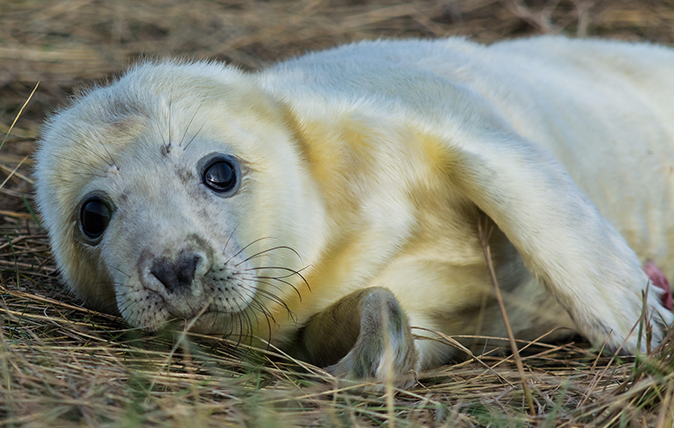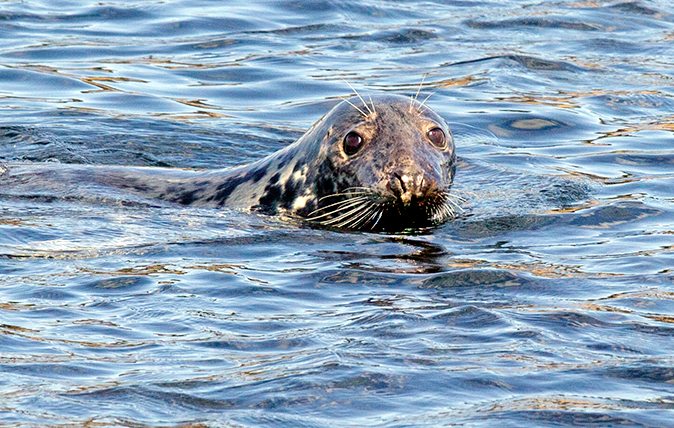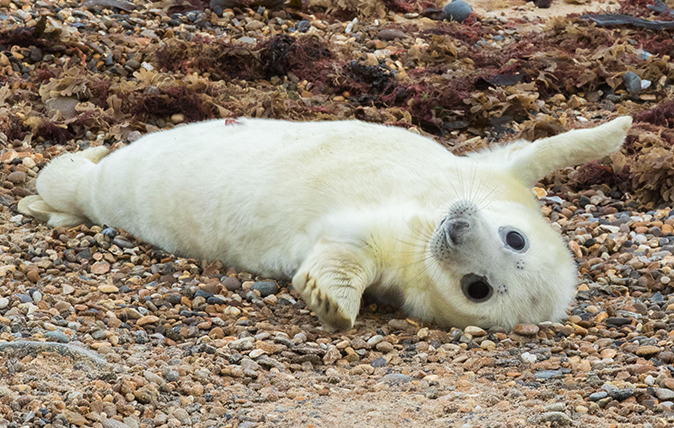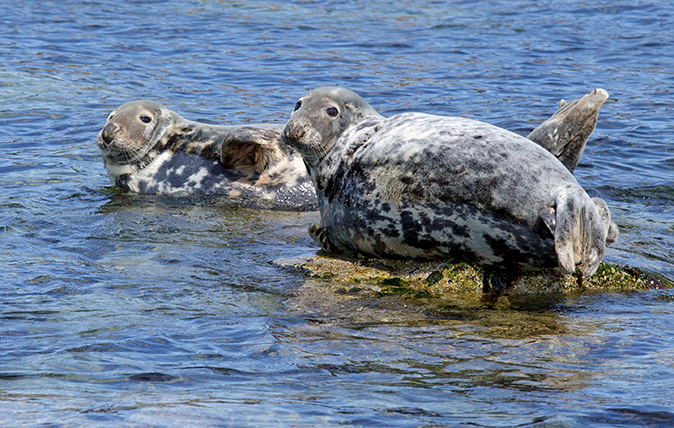Grey seals: The doe-eyed ‘people of the sea’ who are full of surprises
Ignore the doleful eyes and lazy demeanour: these half-tonne monsters are full of surprises, from their rampantly polygamous habits to their ability to control their own heartbeat, as David Profumo explains.


Grizzled, wide-eyed and deceptively benign looking, grey seals can weigh half a tonne and snack on porpoises; sometimes known as ‘people of the sea’, they remain the most mythologised of all our marine creatures.
A denizen of remote and turbulent seascapes, the Atlantic seal is larger and more formidable than the puppyish common, or harbour, seal (Phoca vitulina), which is that paler, spotted species generally gawped at by tourists as it basks on seaweedy shores. Also known as the brun-swine, selchie or powart, the grey’s Latin name – Halichoerus grypus or ‘hook-nosed sea pig’ – is somewhat unflattering, but in Gaelic culture, where it has long been revered, it is simply Ron-Mor: the great seal.

With his thick folds of blubber, an adult bull grey can measure 11ft, although cows are significantly smaller. The skin is actually a brownish-olive and the head sports a distinctive ‘Roman’ nose (as opposed to the more retroussé profile of the common’s).
However, when it comes to anthropomorphic features, the eyes have it: apparently soulful and expressive, greys are even supposed to weep and some admirers claim they dance and kiss, to boot. ‘To see through eyes/That only see what’s real,’ warbled Elton John in Grey Seal (although even Bernie Taupin could never explain his lyrics). Big Ron’s yodelling hoots are sometimes perceived as humanoid and greys are actually believed to respond to music, including church bells.
The grey is an amphibious pinniped or fin-footed mammal. It uses its fore-flippers to ‘haul out’ on land, adopting a galumphing gait, but, in water, it is superbly swift, propelled by sweeps of the hind flippers and is capable of diving down 200ft, holding its breath and slowing down its heartbeat from 150 per minute to just 10 when hunting. Its habit of inquisitive surface bobbing – or ‘bottling’ – makes it one of those animals that seem to observe us.

Seals require some 15lb of food each day – crustacea, herring, squid and conger all have their seal of approval; greys have a particular predilection for salmon and can wreak havoc in river mouths. They even travel far upstream – one was recorded in the Thames at Teddington – and are historically unpopular with those who make a living from the sea, including fish farmers, whose cage nets they often destroy.
At an estimated 112,000, the UK population is about half of the entire world’s and they take hundreds of tonne of fish each year. Some believe this largely protected, burgeoning population now requires management, but there are precious few votes in promoting seal culls, so alternative methods such as darting with contraceptive implants have been considered.
Exquisite houses, the beauty of Nature, and how to get the most from your life, straight to your inbox.
The breeding season lasts from August to December and greys come ashore to form colonies (‘rookeries’) on far-flung islands and skerries – Treshnish, Haskeir and Rona being among their main sites. These become pungent places as, during the rut, the bull exudes a potent, tarry scent.
Rampantly polygamous, Ron possesses an impressive baculum (penis bone) and every cow on the breeding beach tends to become pregnant. Both sexes starve for weeks during this period. Fertilisation is followed by delayed implantation, active gestation recommencing with the February moult.
Single pups appear in late autumn, covered with a creamy natal pelage (lanugo) and are suckled on maternal milk so rich – 10 times fattier than a domestic cow’s – that the calf puts on 4lb every day until weaned.

On both sides of the Atlantic, seals have historically been hunted – the skin was valuable for clothing and, before paraffin, oil-fuelled lamps and has medicinal properties. The sea pig’s reddish flesh was formerly considered sufficiently fishlike to be eaten by Catholics during Lent. In Canada, the once annual, gory carnival of ‘going to the ice’ to club whelps (often baby harp seals) each February habitually enrages ‘eco warriors’, although peoples such as the Inuit still depend on seals for survival and these creatures remain defiantly integral to their culture – their pinniped deity Sedna even has an iceberg-water vodka named in her honour.
In Britain, especially among the maritime Celtic and Gaelic communities, deep-seated myths abound concerning selchies, which were regarded as uncanny and only to be harvested by designated killers (often a hereditary role). In Orkney and Shetland, they were held to harbour the souls of the drowned or be Fallen Angels. Numerous tales of enchantment involve shape shifting, wherein seals shed their ocean skins to venture ashore in human guise – often as comely women – and passionate miscegenation results in tragic consequences.
These fables about forbidden fruit – part of the Fairy Bride genre – underpinned certain clan histories. The MacCodrums of Uist and the Irish Conellys were both believed to have selchie blood in their veins, which accounted for certain physical imperfections – such as webbed fingers – that made them truly people of the sea.
David Profumo
Country Life is unlike any other magazine: the only glossy weekly on the newsstand and the only magazine that has been guest-edited by His Majesty The King not once, but twice. It is a celebration of modern rural life and all its diverse joys and pleasures — that was first published in Queen Victoria's Diamond Jubilee year. Our eclectic mixture of witty and informative content — from the most up-to-date property news and commentary and a coveted glimpse inside some of the UK's best houses and gardens, to gardening, the arts and interior design, written by experts in their field — still cannot be found in print or online, anywhere else.
